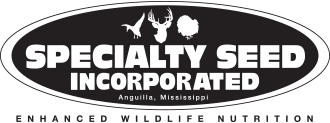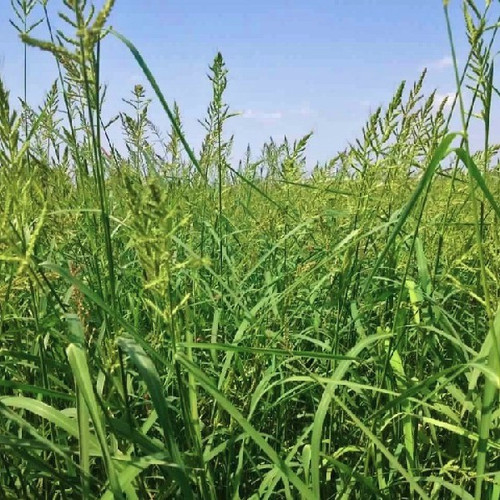Product Description
Barnyard grass (Echinochloa crusgalli) is an annual grass weed most commonly found in newly established turf. Barnyard grass tends to be more prevalent when turf is newly seeded during the hot conditions of summer. It grows faster than the desirable grasses that need cooler temperatures to germinate.
Barnyard grass is a coarse annual grass reaching 1 to 4 feet tall, if not mowed. Stems are thick, coarse, mostly upright branching at the base with a purplish-green color. Flower head or seed head is reddish, purplish or greenish color.
Fortunately, coarse Barnyard grass will be killed by the first frost in Fall. The coarse brown grass decomposes in the Spring and the desirable thin bladed grasses fill in the areas with Spring rains and an application of slow release fertilizer.
Planting Rate: 25 lbs/acre
Barnyard Grass Seeds
Barnyard Grass (Echinochloa crus-galii) is the wild millet that ducks have been eating since the beginning of time. It is easy to grow and ducks love it. It does great in wetlands. Other names it is called are Wild Millet, Barnyard Millet, and Common Barnyard Grass.
Barnyard Grass Planting Guide
Barnyard Grass is a prolific seeder. It makes a small seed that ducks love. It will volunteer several years after the initial planting with proper management. It grows 1’-3’ tall. In wetlands, it performs best with late-growing season water drawdowns. The combination of heat, wet soil, and day length getting shorter puts the plant into high gear! When planting Barnyard Grass seed, it is best to plant it late in the growing season to mimic nature. Plus, it has a short maturity, often 45-60 days. When planted too early in the growing season the first crop may grow and produce seed too early for the ducks to use. You want the seed available for when the ducks show up.
The seeding rate is 12 lbs. – 15 lbs. per acre. There are approximately 175,000 seeds per pound. It does not take much seed per acre to get a good stand of Barnyard Grass.
Barnyard Grass can be planted with a seed drill or by broadcasting. The most common method is broadcasting onto a well-prepared seed bed and covering the seed lightly. Do not cover the seed too deep as it is a small seed. ½" deep is plenty.
There are a few herbicides that can be used to control broad leaves in Barnyard Grass. 2,4-D, Aim and Blazer work well on millets. It is important to spray the weeds when they are young (<4” tall) and actively growing. In drought situations, weeds may not be actively growing and will not uptake the herbicides as well as when they are actively growing. Be sure to follow the herbicide’s label.
Does Barnyard Grass need fertilizer? Barnyard Grass does not require a lot of fertilizer. Waterfowl impoundments are naturally rich due to them being in low-lying areas. They can be high in organic material creating natural fertilizer. It is recommended to pull a soil sample and amend the soil with lime and fertilize per the soil test recommendations. Without a soil sample, a rule of thumb would be to fertilize with 20 units of Nitrogen. So for a fertilizer like 13-13-13 that has 13 units of nitrogen per 100 lbs., the rate would be 154 lbs of 13-13-13 per acre.
Barnyard Grass for Waterfowl
When Barnyard Grass is planted, it cannot be manipulated and hunted over or near for ducks and geese. If a volunteer crop is produced in subsequent years, it can be manipulated and hunted over per Federal rule. It is recommended to contact your state wildlife agency to be sure management actions do not violate any hunting regulations.
Barnyard Grass seed has a high percentage of "hard" seed. This hard seed characteristic is what preserves the seed, keeping it from deteriorating. The seed will persist for a long time under water which is good for feeding ducks. It will also last a long time in the seed bank which will allow it to grow for many years after the initial planting with proper management.
In the following years after the initial planting of Barnyard Grass, keep the water on the impoundment late into the growing season. For example, in the southeast United States holding water until August can produce good stands of wild barnyard grass. In August, if your impoundment is at full pool, you would want to release the water slowly. This may be 4" per week. A lot of times evaporation can do this for you if you have kept all the boards in. You may need to disk the impoundment once every 3rd year to set back succession. Barnyard grass is a great moist soil plant for ducks.
Barnyard Grass Seeds for Sale
If you’re looking to add Barnyard Grass to an impoundment or food plot for waterfowl or other game, check out our selection at Specialty Seeds Inc. We have everything you’ll need for successful Barnyard Grass planting.







